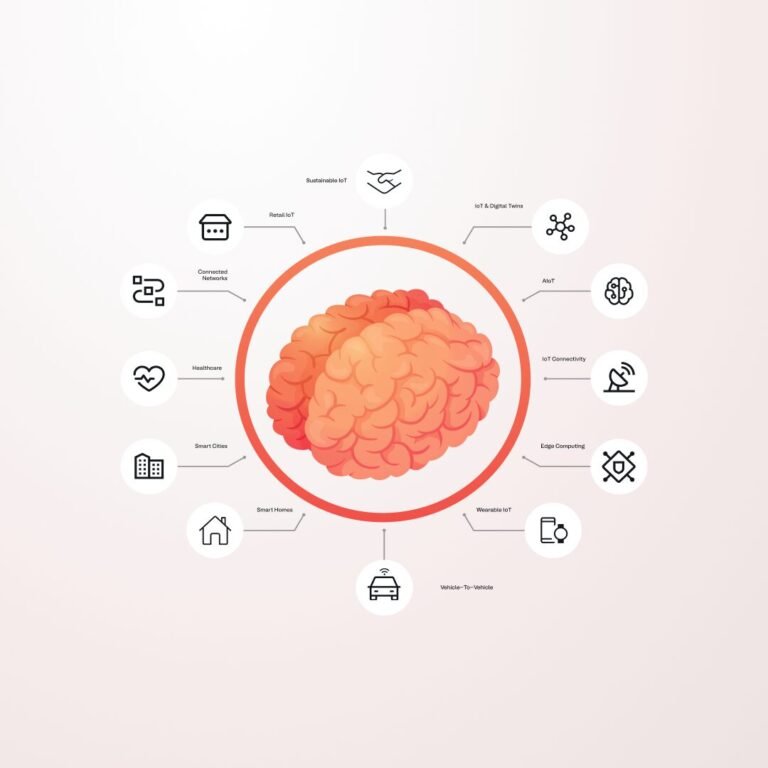IoT Technology Trends 2024: What to Expect and Watch For

IoT technology trends for 2024 are shaping the future of connectivity, automation, and data-driven innovation across industries. As artificial intelligence, machine learning, and data analysis continue to evolve, the Internet of Things (IoT) remains at the center of this transformation. In 2024, businesses are looking beyond connectivity — toward security, sustainability, and smart systems that empower users and improve lives.
The Growth of IoT Technology
The global IoT technology market is projected to reach $1.39 trillion by 2026, according to Mordor Intelligence. This growth is driven by remote monitoring, smart home devices, and AI-enhanced data analytics. The COVID-19 pandemic accelerated this momentum. However, challenges like the semiconductor chip shortage still affect production and costs.
1. AIoT: The Fusion of AI and IoT
One of the most impactful IoT technology trends for 2024 is the combination of IoT and AI—commonly known as AIoT. IoT collects real-time data through sensors, and AI analyzes it to drive intelligent decisions. This synergy powers predictive maintenance, smart energy use, and industrial automation.
2. Connectivity Evolution: 5G, Wi-Fi 6, LPWAN, and Satellites
IoT connectivity has evolved. In 2024, faster wireless communication technologies like 5G, Wi-Fi 6, LPWAN, and satellite networks are boosting the scalability and range of IoT deployments. GSMA offers insight into the infrastructure behind these advancements.
3. Edge Computing: Speed and Security Close to the Source
Edge computing processes data closer to the device, reducing latency and improving performance. For time-sensitive use cases—such as autonomous vehicles or real-time health monitoring—this is essential. Edge computing also boosts privacy by reducing data transfers to central servers.
4. Wearable IoT Devices: From Fitness to Healthcare
Wearable devices like smartwatches and AR/VR headsets are becoming central to digital health and lifestyle applications. In 2024, generative AI is making wearables even smarter—turning them into personalized health assistants and productivity tools.
5. Smart Homes Become Smarter
Smart homes remain one of the most consumer-visible applications of IoT. Devices like Google Nest and Amazon Echo now handle automation tasks like climate control and lighting. Consumer Reports offers reviews and comparisons of smart home tech to guide buyers.
6. Smart Cities and Urban IoT
Urban planners use IoT to optimize transportation, reduce energy usage, and enhance public safety. Smart streetlights, traffic monitors, and waste sensors are just the start. In 2024, V2I (vehicle-to-infrastructure) communications and autonomous shuttles gain traction in cities worldwide.
7. Healthcare and Medical IoT
Beyond wearables, IoT in healthcare enables remote patient monitoring, real-time vitals tracking, and telehealth platforms. According to Fortune Business Insights, the IoT healthcare market is projected to reach $289 billion by 2028.
8. Manufacturing and Industrial IoT
Manufacturing relies on connected sensors to automate workflows, predict failures, and reduce costs. AI-enhanced industrial IoT (IIoT) improves quality control and speeds up decision-making. Cybersecurity remains a top priority as factories become more connected.
9. IoT in Retail: Smart Inventory and Customer Experience
Retailers use IoT for inventory tracking, customer behavior analysis, and automated checkout. Technologies like RFID and in-store heat mapping optimize store layouts and reduce stock issues. Spending in retail IoT is expected to hit $177.9 billion by 2031, according to Allied Market Research.
10. Sustainability Through Smart IoT
IoT is a key driver in the shift toward sustainable operations. Businesses use IoT to track energy usage, reduce waste, and optimize logistics. Smart meters and environmental sensors help measure and reduce carbon footprints.
11. V2V Communication for Safer Roads
Vehicle-to-vehicle (V2V) communication allows cars to share data on location, speed, and traffic conditions. It reduces collisions, improves routing, and lowers emissions. This is a top priority for automakers in 2024.
12. Digital Twins Powered by IoT
A digital twin is a virtual replica of a system or object. With IoT, digital twins now update in real time, supporting infrastructure planning, factory simulations, and predictive maintenance across industries.
13. Brain-Computer Interfaces: The Future of Human-IoT Interaction
Brain-computer interfaces (BCIs) are emerging as cutting-edge IoT applications. In 2024, companies like Neuralink are exploring BCIs that allow thought-controlled interactions with devices. While still experimental, they represent the next frontier.
Final Thoughts: The Power of IoT in 2024
The top IoT technology trends of 2024 span every sector—from smart homes and manufacturing to healthcare and transportation. As technologies like AI, edge computing, and 5G converge, businesses must adapt to stay competitive.
IoT is no longer optional. It’s a strategic tool for growth, efficiency, and resilience.
📩 Ready to explore IoT innovation? Contact Fordewind.io to build future-ready solutions today.
Fordewind.io is an IoT engineering and development company based in Kyiv, Ukraine. Our main areas of interest and expertise are the automotive industry and Smart Home/City projects. Contact us right now without a doubt and learn more about how we can help you build the future.